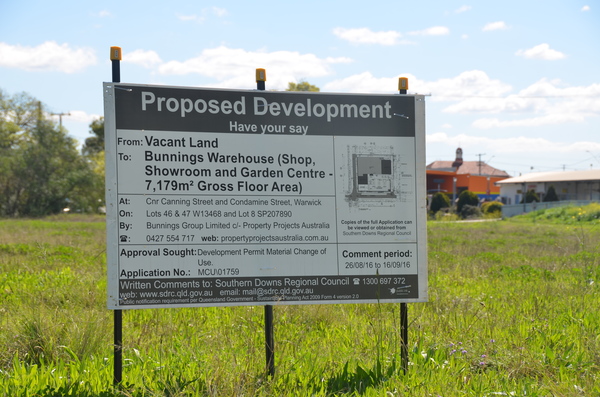OPINION By Jeremy Sollars
BUSINESSES in the vicinity of the proposed new Bunnings in Warwick have every right to be concerned about the potential impact of this massive structure on the floodplain if it’s approved in its current form.
You don’t have to be an engineer to understand that any new amount of fill on the Condamine River floodplain is going to affect the flow of floodwaters in what I always feel is rather quaintly called a “flood event”.
That said, councils are constrained in what they can do as far as development conditions are concerned, thanks to State Government planning laws which overwhelmingly favour developers and landowners. Under Queensland’s current Integrated Planning Act – some in the town planning industry call it the “Disintegrated” Planning Act – nothing can be prohibited by a council. A council can’t just rule that a Bunnings can’t go on a floodplain, end of story. The onus is on the developer to prove that their building won’t have adverse impacts on a surrounding area, and councils have to prove – sometimes in the courts – that any potential impact is real.
And of course, developers want to do things the most cost-effective way they can.
But councils do have wiggle room. They can negotiate with a developer around contentious issues. They can offer certain concessions in exchange for alterations to a proposal to satisfy community concerns and objections and get the best overall outcome for the residents, businesses and ratepayers they represent. They can, to put it bluntly, do a deal.
In the case of the new Bunnings, it seems clear that if the building were to be built on pylons instead of a lump of landfill floodwaters would very likely pass through the area more freely and smoothly and additional impacts on existing structures would be minimal, or perhaps even non-existent, depending on the severity of the flood. The council could, for example, offer concessions in the form of extra parking, or less landscaping, or share the cost of road and drainage upgrades if Bunnings were to agree to the pylon option, which would no doubt be more expensive than landfill. Obviously there would be a cost to the ratepayer, but if it achieves a better outcome then it would be money well-spent.
I am all for new development in town and I have no issues with a new Bunnings at the proposed location, provided the impacts are minimised as far as is humanly possible, given how unpredictable floods can be. Landfill is not the way to go, but if we can work with the developer to find a creative way around that to facilitate new investment and new jobs in Warwick I’d encourage our council to go for it.







